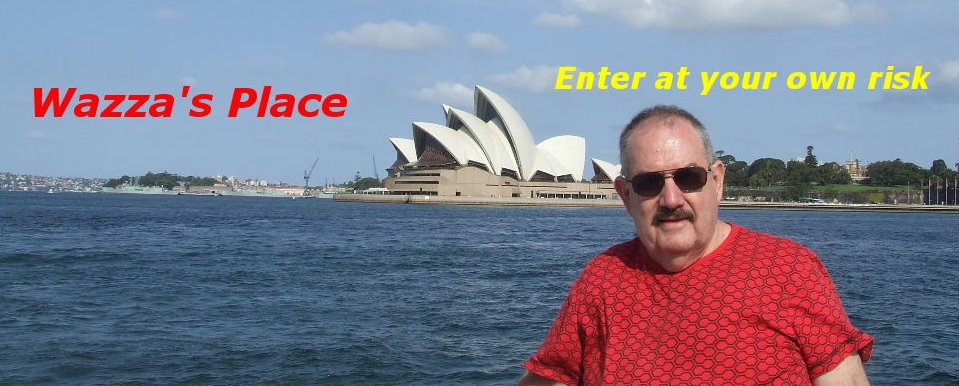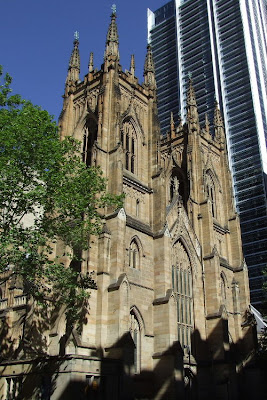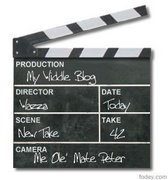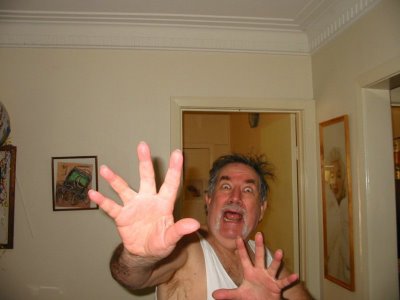Journey to Sydney and Back, Part 4
I’ve sometimes been accused of not posting too often,
but I think blogs can be like a good wine, savoured
with time the results can be quite palatable.
We decided to go into the CBD by train to visit the
magnificent
 Queen Victoria sitting outside of the Q.V. Building.
Queen Victoria sitting outside of the Q.V. Building.
Pierre Cardin, the famous French couturier, is reputed
to have described the
most beautiful shopping centre in the world'.
The building which connects Town Hall railway station
with
magnificent. Built in 1898 and designed to resemble a
Byzantine palace it spent decades in a state of serious
disrepair. Threatened with demolition in 1959 it was
restored at a cost of $75 million and opened in 1982.
It is open seven days a week.
Two views of inside the Queen Victoria Building.
The site on which the QVB now stands was
originally designed as a fresh produce market,
called the Queen Victoria Markets, and was
selected for the construction of a grand
government building. The dominant feature is
the huge central dome, consisting of an interior
glass dome and a copper-sheathed exterior,
topped by a domed cupola. Many smaller domes
in a range of sizes dot the roofline, most notably
a pair overtopping each end of the rectangular
building.
Stained glass windows, including a
cartwheel window depicting the ancient arms of
the City of
area, and the roof itself incorporates arched skylights.
dioramas and moving figures from moments in
Australian history, can be seen from the adjacent
railed walkways. The Royal Clock, designed by Neil
Glasser and made by Thwaites & Reed of
in
King John signing the Magna Carta to the execution
of King Charles I. The Great Australian Clock,
designed and made by Chris Cook, weighs four
tonnes and stands ten metres tall. It includes
33 scenes from Australian history, seen from both
Aboriginal and European perspectives.
Four scenes on the sides of the Royal Clock.
St Mary's Cathedral, located to the east of Hyde Park,
is still incomplete although the foundation stone was
laid in 1868. The location has been used by
Catholics for more than 170 years. In 1821 a stone
was laid on this site and the original Church of the
Blessed Virgin Mary was built. It was destroyed by
fire in 1865 and three years later the foundation
stone of the present cathedral was laid.
The building is classically Gothic in design. Today
it is the centre of
............St. Mary's Catholic Church.
St Andrew's Anglican Church, located in George Street
next to Sydney Town Hall, is
cathedral. The foundation stone was laid by Governor
plans for a typically Gothic cathedral were drawn up
by the convict architect, Francis Greenway.
Unfortunately there was a shortage of funds at the
time and the cathedral got little further than a
foundation stone until 1837 when it was redesigned
by Edmund Blacket in a style which was based on
St Mary's Church in
eventually completed and consecrated on
..................St. Andrew's Anglican Church.
Most large cities have tour buses that take you on
a guided tour and
The bus we went on took ninety minutes to tour the
CBD and one was able to get on and off the bus at
any stop. The ticket could be used for two days.
The first day we just stayed on the tour from start to
finish. The following day Peter went on the Bondi
Beach tour and I went on the same tour except I
got off and on many times to see and take photos
of those sights which I had seen and thought was
worth spending more time than what we have seen
on the first day.
Star City is Sydney's premier 24-hour gaming and
entertainment venue offering Sydney's only casino,
a luxurious 5-star hotel and serviced apartment
complex, 13 restaurants and bars, a state-of-the-art
conference venue, and two world-class theatres.
Located adjacent to
sweeping views of the harbour and the city skyline.
...............Entrance to the Star City Casino.
Set on a 3.34 hectare site - about the size of seven
football fields -
and entertainment destination offering an array of attractions.
Point) is a historical amusement park, located on
the northern
The heritage-listed park first opened in 1935, and
is still open for business, but over its 70-year history,
the park has experienced multiple closures, changes
of ownership, legal battles, and community action in
both support of and opposition to Luna Park's operation.
Originally a prestigious address where the wealthy
built their villas, such as
Cross later became the haunt of bohemian artists
and writers and a ‘rest and recreation’ destination
for servicemen.
In its hey days Kings Cross had a reputation as being
a very “seedy” place with lots of strip clubs with many
“porn” shops peddling “sex for sale”. Today, ‘The
Cross’, along with neighbouring Potts Point and
Elizabeth Bay, is Australia’s most densely populated
district – a famous nightlife and dining area and a
magnet for tourists and locals.
Driving up William Street towards Kings Cross.
The
It commemorates the Australian Army's role in the
siege of
i
since 1792. The park began its life as the city's first
racecourse and was later used as a cricket ground.
fountains and statues that abound inside the park.
The
on
district. It is the oldest hospital in
back to 1788, and at its current location since 1811.
It first attained the name
Currently the hospital comprises 113 inpatient beds.
Specialist services attract patients from all over
South Wales
hand surgery and is a referral hospital for patients
requiring these services.
Many of the 736 convicts who survived the voyage
of the First Fleet from
suffering from dysentery, smallpox, scurvy, and
typhoid. Soon after landing Governor Phillip and
Surgeon-General John White established a tent
hospital along what is now
The Rocks to care for the worst cases.
Il Porcellino, a bronze copy of the Florentine boar,
was donated in 1968 and stands outside the hospital.
Visitors to the
snout to ensure good luck, a tradition that has kept
the snout in a state of polished sheen while the rest
of the boar's body has faded to a dull brownish-green.
Known to Sydneysiders as the Mitchell Library, the
State Library of
repository of historic documents, sketches and
information. The centrepiece of this interesting
combination of old and new buildings is in the
Mitchell Library, the largest collection of colonial
Australiana in the world.
The Archibald Fountain is widely regarded as the
finest public fountain in
J.F. Archibald, owner and editor of The Bulletin
magazine, who bequeathed funds to have it built.
Archibald specified that it must be designed by a
French artist, both because of his great love of
French culture and to commemorate the association
of
The fountain was unveiled on
Four views of the Archibald Fountain and statues.
The last photo of
tour as we drove under the
towards the Opera House.
My next post will be at the
Katoomba and then onto
gardens in country


































5 comments:
G'day Wazza, another excellent post, you certainly extract full value from a holiday and share it so well too.
Great post, Warren and a trip back in time for me. I haven't been to Sydney since 1979!
You're doing great on the blog, Warren! You weren't meant to post every day. Even I have slowed down quite a bit.
Sidney is soooo very pretty. We look at tours which include it but still haven't left, or even booked.
..
Hi Warren ~~ Just took the time to really read Part 4 and again, you have done very well. The photos and all the info are really good. Thanks for taking us in and around Sydney
Take care, Regards, Merle.
Stumbled across your site... I see you were in Sydney... I am originally from Newcastle, NSW but now living in Florida, USA... I would go to Sydney alot and even rubbed the nose of the boar out the front of Sydney Hospital... how it has made me homesick just reading about the place... thank goodness I am going home on a vacation - whoops... holiday (been away from home to long) in January '08... take care
Post a Comment